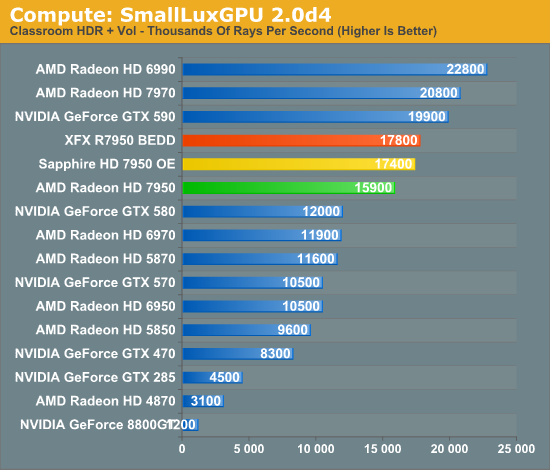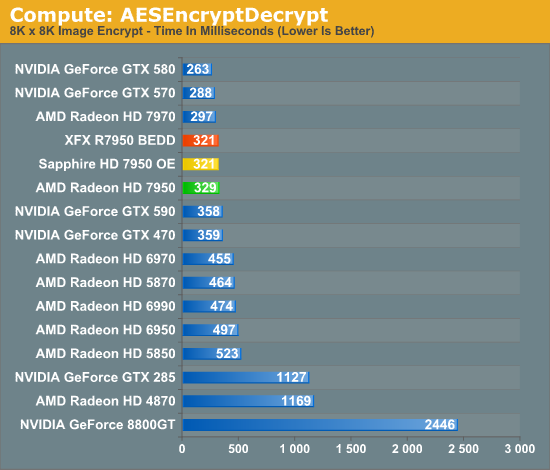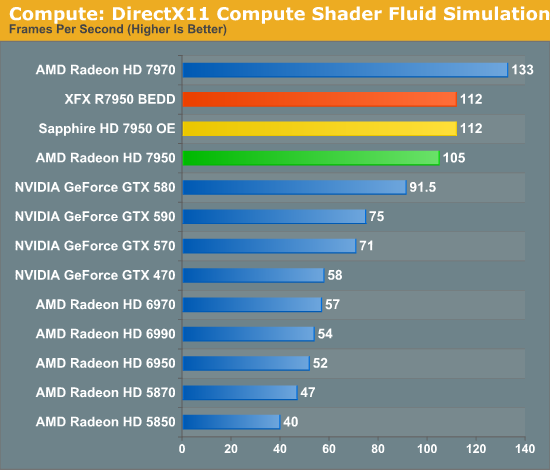AMD Radeon HD 7950 Review Feat. Sapphire & XFX: Sewing Up The High-End Market
by Ryan Smith on January 31, 2012 9:02 AM ESTCompute Performance
Moving on from our look at gaming performance, we have our customary look at compute performance. Since compute performance is by definition shader bound, the 7950 is at a bit of a disadvantage here compared to gaming performance. Whereas ROP performance scales with the core clock, shader performance is hit by both the reduction in the core clock and the disabled CU array.
Our first compute benchmark comes from Civilization V, which uses DirectCompute to decompress textures on the fly. Civ V includes a sub-benchmark that exclusively tests the speed of their texture decompression algorithm by repeatedly decompressing the textures required for one of the game’s leader scenes. Note that this is a DX11 DirectCompute benchmark.

AMD’s greatly improved compute performance continues to shine here, though in the case of Civilization V it’s largely consumed by just closing the previously large gap between the GTX 500 series and the Radeon HD 6000 series. As a result the 7950 falls ever so short of the GTX 580, while the factory overclocked Sapphire and XFX cards give the 7950 enough of a push to come within 5% of the 7970.
Our next benchmark is SmallLuxGPU, the GPU ray tracing branch of the open source LuxRender renderer. We’re now using a development build from the version 2.0 branch, and we’ve moved on to a more complex scene that hopefully will provide a greater challenge to our GPUs.

Under SmallLuxGPU the 7970 enjoyed a large lead over the GTX 580, and this continues with the 7950. Even though the 7950 is well behind the 7970—to the tune of 24%—it’s still 33% ahead of the GTX 580 and the lead only grows from there. Meanwhile the XFX and Sapphire cards can catch up to the 7970 somewhat, but as this is truly a shader-bound test, you can’t make up for the lack of shaders units on the 7950.
For our next benchmark we’re looking at AESEncryptDecrypt, an OpenCL AES encryption routine that AES encrypts/decrypts an 8K x 8K pixel square image file. The results of this benchmark are the average time to encrypt the image over a number of iterations of the AES cypher.

In spite of being a compute benchmark, AESEncryptDecrypt is not particularly sensitive to GPU performance, showcasing the impact that setup times can have. The 7950 trails the 7970 by 10%, and overclocking doesn’t change this much. Unfortunately for AMD NVIDIA is still the leader here, showing that AMD’s compute performance still has room to grow.
Finally, our last benchmark is once again looking at compute shader performance, this time through the Fluid simulation sample in the DirectX SDK. This program simulates the motion and interactions of a 16k particle fluid using a compute shader, with a choice of several different algorithms. In this case we’re using an (O)n^2 nearest neighbor method that is optimized by using shared memory to cache data.

With the compute shader fluid simulation we once again shift back into a compute task that’s much more shader-bound. The 7950 only reaches 80% of the performance of the 7970, once more proving the real impact of losing a CU array. This is still enough to handily surpass the GTX 580 however, with the 7950 taking a 15% lead.










259 Comments
View All Comments
chizow - Saturday, February 4, 2012 - link
I have explained this. Because the market expects there to be a shift in the price:performance metrics when a new generation or new architecture of GPUs launches. This is the driving factor of progress, more performance at the same prices.Tahiti offers none of this, so once again, AMD is either ignoring the fact Nvidia 28nm parts are imminent and may very well invalidate their entire product line a few months after launch. Or they think Nvidia's 28nm parts aren't any faster than their 40nm parts. Or they think their customers are stupid.
In all 3 cases, I can't see this ending well for them. Unless Nvidia prices their new parts to the moon like $750+, and then no one wins (or has any reason to upgrade for that matter). The only people who would have any incentive to upgrade will be the ones who need to have the absolute fastest, then they'll have to decide if $750/1500/2250/3000 is worth it for a minor bump in performance over what they had with $500 flagship parts.
chizow - Saturday, February 4, 2012 - link
Well, you'd be stupid not to verify and fact check what I've stated by referencing the financials before opening your mouth. Its all right there, links and everything.Given your other comments on the topic however, ignorantly commenting seems par for the course with you.
chizow - Saturday, February 4, 2012 - link
I'm well aware of that. I'm also well aware that top-end performance from 3 years ago doesn't command $1000 prices anymore, it fetches $300 max. That's what we call progress.Its also why AMD can only charge $200 for their top-end CPU, because what they have today still doesn't compete with what Intel has at $300 today and what they asked $1000 for 3-years ago.
But its OK, you've made it abundantly clear you see nothing wrong with charging the same price for the same performance as last-gen parts some 14 months later.
chizow - Saturday, February 4, 2012 - link
Is it nice for you? Because you're clearly out of your league in this discussion.chizow - Saturday, February 4, 2012 - link
CYA!Galidou - Sunday, February 5, 2012 - link
Oh yeah, if the pricing is so stupid, why is it out of stock everywhere after a week?Oh right, supply and demand is a market thing but the only thing you understand is history of pricing and ATI being a company that doesn't know what they do, maybe you should become marketting master, seems like you'Re right about everything in the damn world...
Galidou - Sunday, February 5, 2012 - link
They freaking knew what they were doing FFS.And from the beginning I knew nothing was SO wrong with it because if it was the case, they wouldn't of sold EVERYTHING in a damn week...
Prices will go down soon, they just knew the initial stock would sell like hotcakes and when it starts to slow down, price it accordingly.
Supply and demand...
chizow - Saturday, February 4, 2012 - link
And apparently this is the same mistake AMD has made by shoving in their head in the sand trying to ignore that ominous cloud called Kepler.Its fine, buy these cards today, regret the decision tomorrow, a month from now, two months from now.
I know the AMD fanboys probably hate me today for pointing this out and shoving it in their faces, but I can guarantee you anyone who buys one of these cards today won't be mad at me when Kepler cuts their price at the knees, they'll be pissed off at AMD.
chizow - Saturday, February 4, 2012 - link
This is the online equivalent of holding your hands over year ears and shouting "lalala I can't hear you lalala".Your arguments were pretty weak to begin with but now they've just devolved into childish nonsense.
chizow - Saturday, February 4, 2012 - link
Um, no you're wrong.How is it a bad thing when Apple can't meet demand on iPhone? Or Nintendo can't meet demand on Wii? Or Amazon can't meet demand on Kindle? Or Nvidia can't meet demand on Fermi? Or AMD can't meet demand on Cypress?
Demand oustripping supply is any economist or business owner's dream situation lol, if you don't under this YOU have no understanding of very basic economic principles.